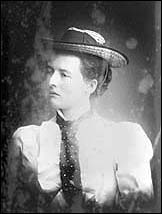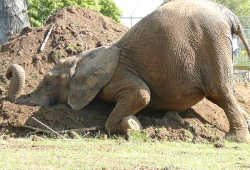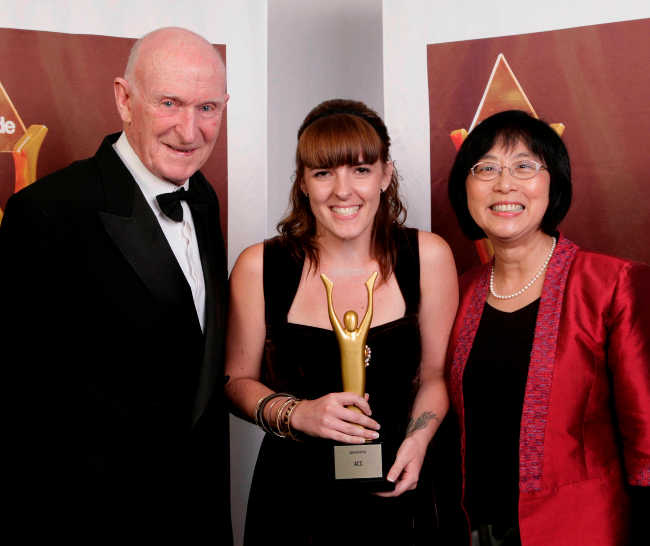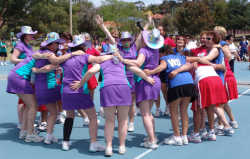Dorothy – 02/08/02
Maud Pember Reeves (née Robison), one of the influential New Zealand women of her generation, grew up to be part of Christchurch’s social set, but sought tertiary education, mixed in political circles after marrying socialist politician William Pember Reeves, was an active supporter of women’s suffrage and after moving to London joined the Fabian socialists and undertook sociological research into the lives of London’s poor.
Magdalen Stuart Robison was born on 24 December 1865 at Mudgee, New South Wales, Australia. Her father, William Smoult Robison was a bank manager and in 1868 he was appointed as manager of the Christchurch branch of the Bank of New South Wales – a post he held for thirty one years. She was called Magdalen after her mother, Mary Magdalen Saunders, but was known as Maud.
|
|
| Maud Pember Reeves (nee Robison) |
She was the second of eight children in the family, five boys and three girls. Over the years Maud was particularly close to her sister Euphemia Caroline (Effie) who was two years younger than Maud.
Maud was a very intelligent girl and after her primary school education at Christchurch East School she attended Christchurch Girls’ High School where she was a foundation pupil.
After she left school she joined in the social and charitable activities in Christchurch – balls, garden parties, picnics, yachting parties, galas, charity bazaars. and the November race meetings – occasions for wearing the latest fashions. Maud was very interested in theatre, both visiting operatic companies from overseas, and local productions of light opera, but she regretted the lack of serious drama. The depression of the 1880s made little impact on the lives of the daughters of well-to-do families, and Maud knew little of the poverty and industrial unrest of the early 80s.
Marriage and family In 1883 she became engaged to William Pember Reeves., and in 1885 they
were married (wedding). She was nineteen, and he was eight years her senior.
Partly because she was married to a political journalist Maud became more aware of the political issues and social problems of the day.
She had one stillborn child and then on 1 July 1887 Amber was born. In 1889 Maud became lady editor of the weekly paper, the Canterbury Times, of which Will was now editor. Her role as lady editor meant that she had to produce the women’s page which contained the news of most interest to women of that time – social events and fashion. Sometimes Maud would include accounts of women’s successes in education and employment.
In August she had a second daughter, Beryl, but this did not halt her drive for education.
University studies After the birth she enrolled at Canterbury College to study for a BA degree. She joined over a hundred women students at the College. Like many others she studied English under Professor John Macmillan Brown. His courses involved essay writing followed by discussing them with the professor or his assistant, O. T. J. Alpers. She also studied French and mathematics. This meant that she had a very busy life, with two small children, studying and actively assisting Will in campaigning and carrying out his political duties. It was as well that she had servants and family to help her with the children as Will, like most husbands in well-to-do families at that time, took no part in caring for them, and was also away from home a lot with his duties as a Member of Parliament.
Maud joined the Dialectic Society at the University. Not only was she keenly interested in the debates, but she played Olivia when the Society put on scenes from Twelfth Night.
Interest in political issues She read widely about the political issues of the day, having access to many books, tracts, and articles which Will brought home. Many of these expressed radical viewpoints. Will’s own writings made his socialist ideas clear. The views of John Stuart Mill on social equity were espoused by a number of Members of Parliament. He and his wife Harriet Taylor Mill supported the liberation of women. In 1878 an Electoral Bill which gave women the vote but not the right to stand for Parliament went through both New Zealand Houses of Parliament, but did not become law because of a disagreement between the two houses about the Maori vote. This was enough to spur women to action.
In 1885 the Women’s Christian Temperance Union (WCTU) was formed. Those who were interested in the political rights of women, under their leader Kate Sheppard, began to work for the vote for women. Kate, fortunately, realised that in Christchurch there was a lot of support for women’s suffrage from people in the liberal political tradition, like Maud Reeves, who did not support the temperance lobby. Maud Pember Reeves organised a women’s section of the local Liberal Association and became the first president.
Move to Wellington For the first term as a Member of Parliament Will was on the opposition benches and the family continued to live in Christchurch. However, with the success of John Ballance’s party in 1890 Will was given the portfolios of Education and Justice. This meant that the family had to move to Wellington. This put an end to Maud’s university course and transfer to a course in Wellington was not an option as there was no university there at that date. She knew that women were not included in the political activities of their husbands. She did not want to leave her supportive family and friends. The advantage was that Wellington was considered a healthier place to live because of the poor drainage system in Christchurch.
Working for women’s suffrage Maud found a political cause to work for in Wellington, joining with Ellen Ballance, the wife of the Prime Minister, to win support for women’s suffrage, in particular collecting signatures for petitions.
She and Ellen Ballance were in the public gallery listening to the debate in Parliament when Henry Fish, representing the drink trade, said that women did not want the vote. Ellen Ballance organised a petition stating that women did indeed want the vote, passed it around the gallery, got sixty eight signatures and presented it to Parliament. They worked on their embroidery in the gallery, countering claims that suffragists were losing their femininity.
In 1892 Maud returned to Christchurch to attend the first meeting of the Canterbury Women’s Institute. Their aim was to support women’s franchise, but not the temperance or the Christian aspect of the WCTU, and to admit men to membership.
After being rejected in 1891 and 1892 the bill giving the vote to women was finally passed on 19 September 1893. Maud took on the role of educating and encouraging women to make use of their vote. On 11 October she chaired a well attended meeting of the women’s section of the Canterbury Liberal Association. This was the first political meeting of enfranchised women held in New Zealand. It was thought that the votes from women played a significant part in Will’s re-election that year.
In 1894 Maud was invited to accompany Ellen Ballance on a trip to England. Her mother in Christchurch looked after Amber and Beryl. Will lived at the Wellington Club. It seems certain that they joined in suffrage activities in England. Kate Sheppard was also in England that year and met with suffrage leaders there. It may be that Maud was in touch with members of the Fabian Society. Certainly Maud and Will made clear their support of the socialist cause when they had a son the following year and called him Fabian.
Move to London In 1896 Will became agent-general for New Zealand in the United Kingdom, and the family moved to live in London. They were welcomed and entertained by the members of Fabian Society and became friends with Sidney and Beatrice Webb, G. B. Shaw and H. G. Wells . They joined Shaw on cycling expeditions.
Maud was in her element in London discussing her socialist views, attending serious theatre, and supporting the feminist movement, In 1898 she addressed the annual conference of the Women’s Liberal Association and in 1899 she presented a paper at a congress convened by the International Council of Women.
Effie and daughters join the household In 1893 Effie married Cecil Lascelles and they had two daughters. In 1899 Cecil Lascelles was killed in an accident and in 1900 Effie and her daughters went to live with the Pember Reeves family. This was not an unusual situation at that time as there was little financial support for many widows. Effie’s name was Euphemia Caroline, and in the family she was called Aunt Carr. Maud’s granddaughter, Annajane, remembers Aunt Carr with great affection as a vital part of the household.
Maud joins the Fabian Society Will felt that his position prevented him from joining political organisations, but Maud became a member of the Fabian Society in 1904 and was a member of the executive from 1907-1919. H. G. Wells tried to reform the Society in 1906, but he handled the issues tactlessly and antagonised the long-standing members He accused the Fabians of ‘arrested development’ and wrote some highly critical pamphlets about them. Maud had supported his ideas, and acted as conciliator in the dispute, helping to prevent a rift. She pushed for her own reform and by March 1907 was successful in getting members to acknowledge sexual equality – a significant triumph.
Working for women’s health In 1907 Maud formed the Fabian Women’s Group (FWG). They worked for equal opportunity and economic independence for women, and organised seminars and published tracts. Maud’s role was as a committee member, a speaker and a writer. She was particularly concerned about mothers with young children, declaring that they worked as hard as anyone, but had no economic independence, and were dependent on husbands who often did not, or could not, support them. In 1909 she started a survey of the health of mothers and children of low-income families in the borough of Lambeth. On medical matters she had the help of Dr Ethel Bentham. With her sister Effie Lascelles Maud visited over thirty families twice a week for nearly four years. Her first report, Family Life on a Pound a Week , was largely based on the information they collected and was published as a tract by the Fabian Society. In 1913 she published her research as the book, Round about a Pound a Week.
Maud also led the Fabian Society into support of women’s suffrage activities, using her experience in the New Zealand suffrage campaign in her persuasive speeches.
Amber’s studies, relationship with H. G. Wells, her marriage and the birth of her daughter By 1904 Amber had finished her secondary education and was offered a choice between being presented at Court and going to Cambridge. Being her mother’s daughter she chose Cambridge and went to Newnham College in 1905. She achieved brilliant success academically and as her mother did in Christchurch she became a member of the debating society. She proved to be a very able debater. In 1906 she was involved in the formation of the Cambridge University Fabian Society, the first Cambridge society to have women as members from the beginning. The young people in this group were mainly following the example of their forward looking parents. H. G. Wells was a speaker at a meeting of the society and the students were immensely impressed by him. He was a married man with a family, but he stated openly his belief in sexual freedom – unlike most of his Edwardian contemporaries. Amber completed her three year degree at Cambridge and in July 1908 she achieved a double first. That summer her friendship with H. G. Wells developed into a love affair and she became pregnant. Before the baby was born in 1909 she married Blanco Rivers White who had been wanting to marry her for some years – a marriage that turned out happily.
Family sadness and the death of Fabian Amber’s affair with Wells caused temporary estrangement from her family, and further sadness was to follow when Fabian was killed when his plane was shot down over Graincourt in France in 1917. Alister Robison, Maud’s nephew, refers to this and mentions Maud’s stoical reaction in Letters from World War 1, letter 47.
Official role researching health problems During the 1914-18 war there was general concern about people’s health. Because of her experience in health research Maud was appointed in 1916 to a committee of inquiry into the high cost of food. From 1917 to 1919 she was employed by the Ministry of Food to work on propaganda for voluntary rationing of food and as Director of Women’s Services.
More suffrage work Women were given partial voting rights in 1918 and Maud was again involved in educating women to use their vote. She was also appointed to the Council of the National Union of Societies for Equal Citizenship.
Maud’s later years Her later years were spent in caring for Will as his health made life difficult for him and in caring for other members of her family. She and Effie visited New Zealand with Will on a business trip in 1925.
After Will’s death in 1932 she lived for some time with Effie in Cambridge. She and Effie were very keen bridge players. They made frequent visits to America to visit Maud’s second daughter, Beryl, who had married Eric Clark, an American whom she met during World War 1. When Effie died Maud lived in retirement homes near Amber who lived in Hampstead.
Maud died in her sleep on 15 September 1953.
If you want to read more about Maud Pember Reeves I strongly recommend Ruth Fry’s “Maud and Amber” published in 1992 by the University of Canterbury Press.





